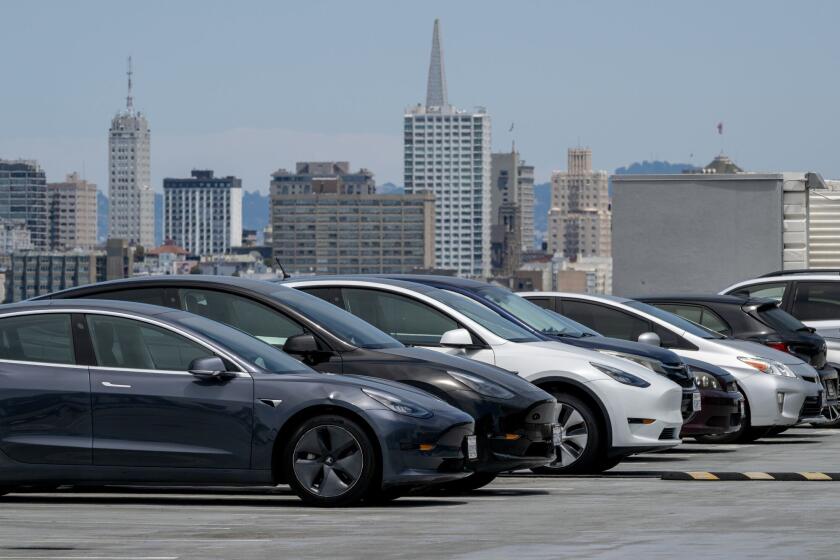Meetings going ‘topless’
- Share via
SAN FRANCISCO — As the capital of information technology, Silicon Valley may have more gadgets per capita than any other place on the planet. Yet, even here, “always on” can be a real turnoff.
Frustrated by workers so plugged in that they tuned out in the middle of business meetings, a growing number of companies are going “topless,” as in no laptops allowed. Also banned from some conference rooms: BlackBerrys, iPhones and other devices on which so many people have come to depend.
Meetings have never been popular in Silicon Valley. Engineers would rather write code than talk about it. Over the years, companies have come up with innovative ways to keep meetings from sucking up time. Some remove chairs and force people to stand. Others get everyone to drink a glass of water beforehand.
But as laptops got lighter and smart phones even smarter, people discovered a handy diversion -- making more eye contact with their screens than one another. It became so pervasive that Todd Wilkens, who works at a San Francisco design firm, waged a “personal war against CrackBerry.”
“In this age of wireless Internet and mobile e-mail devices, having an effective meeting or working session is becoming more and more difficult,” he wrote on his company blog in November. “Laptops, Blackberries, Sidekicks, iPhones and the like keep people from being fully present. Aside from just being rude, partial attention generally leads to partial results.”
Wilkens’ firm, Adaptive Path, now encourages everyone to leave their laptops at their desks. His colleague, Dan Saffer, coined the term “topless” as in laptop-less. Mobile and smart phones must be stowed on a counter or in a box during meetings.
“All of our meetings got a lot more productive,” Wilkens said.
It’s not exactly attention deficit. Linda Stone, a software executive who worked for Apple Inc. and Microsoft Corp., calls it “continuous partial attention.” It stems from an intense desire to connect and be connected all of the time, or, in her words, to be “a live node on the network.”
Etiquette has suffered in the process. “Face-to-face meetings have become a low priority because they’re constantly being interrupted by technology, and many people can’t figure out what to do,” said Sue Fox, author of “Business Etiquette for Dummies.” “What’s more important -- the gadget or the person, or people, you’re with?”
High-tech distractions
The ever-increasing speed and power of technology allow people to effortlessly toggle back and forth between tasks. The wireless revolution has only accelerated this trend, turning every laptop computer into a lightning-quick, mobile communications hub. Attention is increasingly at a deficit in all facets of society -- the workplace, the classroom, the city council meeting and the social occasion.
Universities, for example, invested small fortunes in wireless Internet only to come to an alarming conclusion: Access designed to boost learning quickly became an irresistible distraction. University of Michigan law school professor Don Herzog said students were hunting for sublets, reading the newspaper, checking stock quotes or sending e-mail during class.
The law school blocked wireless access in classrooms. When that didn’t work, some professors banned laptops. The reaction from students was mixed: Some said they were grateful to be able to concentrate, others were sullen, Herzog said.
As technology becomes cheaper and more powerful, the debate is intensifying about how far universities should go in restricting its use in classrooms. Most graduate schools including the UCLA Anderson School of Management let professors decide whether they should limit laptop use. More than 75% of professors at UCLA’s law school shut off Internet access in their classrooms, said Sean Pine, the law school’s chief information officer.
Late last year, Jeremy Zawodny, who works with outside software developers at Yahoo Inc., attended his first “no laptop” meeting at the Sunnyvale, Calif., Internet company.
“I looked around in amazement that no one had their laptops open,” he said. “I try not to bring my laptop to meetings because the pull is strong if I am not interested in something or if the topic doesn’t directly involve me.”
After attending a few such meetings, Zawodny blogged about it earlier this month. He said he felt conflicted. On the one hand, he said, he was tempted to skip meetings if colleagues divided their attention. On the other, it’s “absolutely ridiculous that we have to mandate common courtesy and force people off their laptops long enough to have a useful meeting,” he wrote.
Zawodny’s post got a thumbs-up from Nelson Minar, a former Google Inc. engineer, who says supervisors can be the worst offenders.
“One of my biggest frustrations when I was an engineer at Google was being summoned to an executive meeting only to find three-quarters of the executives too busy with their laptops. I’d spend hours preparing a summary of my project status, a briefing on a new strategy area, or a review of staffing assignments. As requested,” Minar commented on Zawodny’s blog. “Nothing communicates disrespect to your reports like ignoring them when they’re with you.”
Minar declined to be interviewed.
Urge to unplug
The folks at Dogster Inc., the San Francisco company that runs the sites Dogster.com and Catster.com, decided to cut the cord about a year ago. The decision was in keeping with their philosophy of creating a collaborative culture, co-founder John Vars said.
“Even if people are just taking notes, they are not giving the natural human signals that they are listening to the person who is speaking,” he said. “It builds up resentment. It can become something that inhibits good teamwork.”
Bottom line, Vars said: better, more efficient communication. “Meetings go quicker and there is also just a shared experience. People are communicating better, the flow is faster.”
Not everyone feels the urge to unplug. Selina Lo doesn’t mind if her employees multi-task in meetings. The energetic chief executive of Ruckus Wireless, a Sunnyvale-based Wi-Fi company, is a known workaholic. She flashes $50 bills at off-duty cab drivers and delivers clipped answers to complex questions to save time.
“Occasionally, if I see someone too absorbed reading e-mails, I will elbow them,” Lo said. “People are going to get distracted. It’s OK as long as it is not for an extended period of time. I get distracted myself. That’s just how meetings are nowadays.”
And that makes some people wonder if by focusing on gadgets and gimmicks, everyone’s missing the real problem.
Minimized meetings
“People hate most meetings,” Zawodny said. “No one teaches anyone to run them correctly. They become a source of frustration.”
That frustration is so widespread that some start-ups cut meetings short or do away with them. Mountain View, Calif., Internet company Plaxo Inc. took a “meat ax” to meetings, moving them all to Tuesdays with the goal of making other days more productive. (They called it “Meataxo.”) San Francisco e-mail start-up Xobni Corp. has been known to use a stopwatch to keep team updates under two minutes during daily lunch meetings.
Photo-sharing site SmugMug Inc. in Mountain View is an “anti-meeting” company, founder Don MacAskill said. “We have a single all-hands meeting once per week, and the emphasis is on getting it over fast. Each person is expected to answer the question ‘What am I working on this week?’ and is expressly forbidden to talk about what they did the week before, make announcements, ask questions, etc.”
That sounds about right to Joe Lazarus, Yahoo’s former director of marketing, who left in November to consult and start his own company. He weighed in on Zawodny’s blog: “No laptop meetings make sense. No meetings make even more sense.”
--






